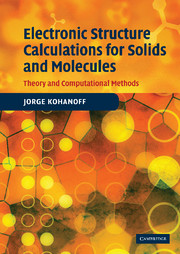Book contents
- Frontmatter
- Contents
- Preface
- List of symbols
- List of acronyms
- Part I Theory
- 1 The problem of the structure of matter
- 2 The electronic problem
- 3 Quantum many-body theory: chemical approaches
- 4 Density functional theory
- 5 Exchange and correlation in DFT: approximations and their performances
- Part II Computational methods
- Index
4 - Density functional theory
from Part I - Theory
Published online by Cambridge University Press: 29 May 2010
- Frontmatter
- Contents
- Preface
- List of symbols
- List of acronyms
- Part I Theory
- 1 The problem of the structure of matter
- 2 The electronic problem
- 3 Quantum many-body theory: chemical approaches
- 4 Density functional theory
- 5 Exchange and correlation in DFT: approximations and their performances
- Part II Computational methods
- Index
Summary
Parallel to the approaches described in the previous chapter, a different line of thought drove L. H. Thomas and E. Fermi to propose, at about the same time as Hartree (1927–1928), that the full electronic density was the fundamental variable of the many-body problem. From this idea they derived a differential equation for the density without resorting to one-electron orbitals (Thomas, 1927; Fermi, 1928). The original Thomas–Fermi approximation was actually too crude, mainly because the approximation used for the kinetic energy of the electrons was unable to sustain bound states. However, it set up the basis for the later development of density functional theory (DFT), which has been the way of choice in electronic structure calculations in condensed matter physics during the past twenty years, and, recently, it also became accepted by the quantum chemistry community because of its computational advantages compared to post-Hartree–Fock methods of comparable quality.
This chapter is organized as follows: we first give an account of Thomas–Fermi theory and then present a modern approach to DFT that takes into account the formal properties of density functionals. We then move into the core of DFT by stating the basic theorems and developing the mathematical framework of orbitalbased (Kohn–Sham) DFT. Next, we describe the most common approximations to exchange and correlation. A detailed analysis of these approximations and a general idea of which kind of systems can be safely treated within them is deferred to Chapter 5.
Thomas–Fermi theory
Thomas (1927), and independently Fermi (1928), gave a prescription for calculating the energy of an electronic system exclusively in terms of the electronic density.
- Type
- Chapter
- Information
- Electronic Structure Calculations for Solids and MoleculesTheory and Computational Methods, pp. 51 - 74Publisher: Cambridge University PressPrint publication year: 2006
- 2
- Cited by

